| | Water Erosion Control Structures | Buffer Zones and Riparian Areas | Shelterbelts | Strip Cropping | Cover Crops | Emergency Wind Erosion Control
In many cases, practices like reduced tillage or direct seeding are sufficient to control wind and water erosion. However, areas that are especially prone to erosion may require additional actions.
Water Erosion Control Structures
The following measures are used to control severe erosion problems such as gullying. For such problems, obtain technical advice to find the best solution for your situation.
Grassed waterways are broad, shallow channels designed to carry surface water without causing soil erosion. The grass cover slows the water flow and provides protection against the cutting action of water. The grass also helps trap sediments and other contaminants in the water.
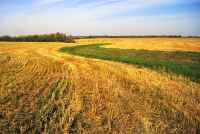
Grassed waterways are broad, shallow channels.
Courtesy of ARD
Lined channels are a means of dropping water to lower elevations along steep parts of a waterway. The steep portions are precisely shaped and carefully lined with heavy-duty erosion control matting, a type of geotextile product. The lining is covered with a layer of soil and seeded to grass. The resulting channel is very resistant to erosion. Lined channels are appropriate for waterways that carry water only occasionally and have slopes up to 10%. Companies that sell geotextile products can provide detailed information on installation of their products.
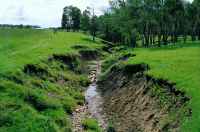
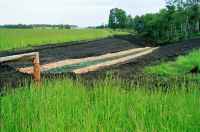
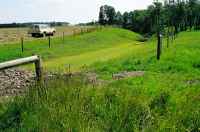
Construction of a lined channel.
Courtesy of ARD
Drop structures are constructed along waterways to drop water to lower elevations without causing erosion (Figure 3.5). They are constructed of concrete, wood, metal or rock. Drop structures are the most costly but occasionally the most appropriate form of erosion control at specific locations along a waterway.
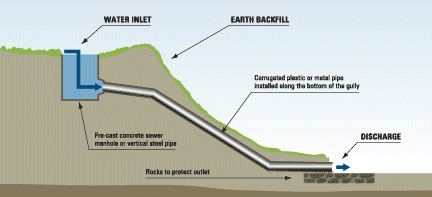
Figure 3.5. Drop structure
Adapted from: Vanderwel, D. and Abday, S. 1997. An Introduction to Water Erosion Control. Agriculture and Rural Development, Agdex 572-3.
Buffer Zones and Riparian Areas
A buffer zone is an area of land developed or conserved to reduce erosion, intercept contaminants and provide wildlife habitat along the side of a stream or lake. Riparian areas are lands adjacent to streams and lakes where the vegetation and soils are strongly influenced by the presence of water.
Healthy, well-vegetated buffer zones and riparian areas minimize impacts from runoff on streams and lakes by filtering out some of the soil particles and other contaminants before the runoff enters the water body. They also protect stream banks and lake shorelines from erosion, and they store water, help in recharging groundwater, reduce flood damage, and enhance fish and wildlife habitat.
Healthy buffer zones and riparian areas can remove up to 50% of phosphorus, 90% of sediment and 80% of nitrate runoff from fields before the runoff reaches the water body. In general, the wider the buffer zone, the more buffering it provides.
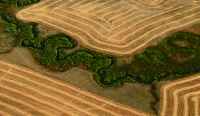
Buffer zones and riparian areas minimize impacts on streams and lakes.
Courtesy of Cows and Fish Program
To fulfil these functions, the buffer zone and riparian area must be well vegetated with a variety of plant types suited to the local conditions. If these areas are seriously damaged, for example by erosion or flooding, the damage should be repaired.
- For more information, see The Health of Our Water (AAFC) or Cows and Fish's Caring for the Green Zone, or visit the Cows and Fish Program website (http://www.cowsandfish.org/).
Shelterbelts
A shelterbelt is a barrier of trees or shrubs. Field shelterbelts are used to shelter agricultural fields, while farmstead shelterbelts are planted around farmyards or livestock facilities. Trees and shrubs are also planted in blocks for woodlots or wildlife habitat.
Field shelterbelts decrease wind erosion by reducing wind speeds for distances up to 20 times the height of the trees (Figure 3.6).
They also trap snow for increased spring soil moisture, reduce wind damage to crops, decrease evaporation of soil moisture, and store carbon.
Shelterbelts are most effective when planted across the prevailing wind direction. For increased sheltering effects, the shelterbelts can be spaced more closely together; for maximum wind erosion control, plant the rows less than 200 m (660 ft) apart.
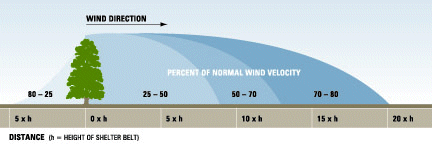
Figure 3.6. Approximate reduction of wind speed by a single-row shelterbelt
Adapted from: Figure 1 in Timmermans, J. and Casement, B. 1994. Field Shelterbelts for Soil Conservation. Alberta Agriculture and Rural Development, Agdex 277/20-3.
To get the maximum benefit from your shelterbelts, you will need to design the belt, select species suited to your site, prepare the site for planting, control weeds for the first few years after planting, and do pruning, watering and other maintenance. New options for shelterbelt weed control - such as plastic, fabric or bark mulches - have reduced the effort required to establish shelterbelts. Manage shelterbelts for longevity; for example, if some of the trees in the shelterbelt die, they should be replaced.
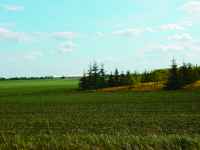
Multispecies shelterbelts reduce the risk of a single disease wiping out an entire shelterbelt system.
Courtesy of Agriculture and Agri-Food Canada - PFRA
Strip Cropping
Strip cropping is the practice of alternating strips of crops with strips of fallow. The strips run along the contours of the land if the main purpose is to reduce water erosion. They go across the prevailing direction of wind if the main purpose is to reduce wind erosion. Crop residues on the fallow strips are retained with reduced tillage fallow or chemfallow. The strip width is based on the convenient width for equipment operation.
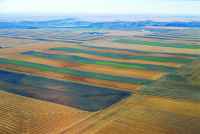
Strip cropping helps to reduce erosion on fallow land.
Courtesy of ARD
- For more information, see Strip Farming for Wind Erosion Control (AAFC - PFRA).
Cover Crops
A cover crop for erosion protection is usually planted later in the growing season (e.g. early August) to provide enough leafy top growth to protect the soil. It may be planted just before a fallow year or after crops such as sugar beets, potatoes and beans that leave little residue cover.
Cover crops are typically spring cereals, which are inexpensive to seed, killed by freezing over the winter, and competitive with weeds in the fall but not competitive with the following crop.
Cover crops use some of the nutrients in the soil but only for a short time, and the used nutrients are cycled back through decomposition, becoming available to the subsequent crop. The amount of soil moisture used by the cover crop is small and comes from shallow depths, and it is usually replaced over the winter.
Emergency Wind Erosion Control
Wind erosion may still occur even if preventive measures are taken. Dry soil, poor snow cover, poor residue cover from low-yielding crops, and persistent strong winds make controlling erosion a formidable challenge.
Emergency controls are used when wind erosion is imminent or has started. The two basic types of emergency measures are: increasing the surface roughness of a field; and covering the soil with straw or manure.
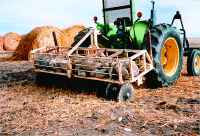
A straw crimper can be used to anchor straw for emergency erosion control.
Courtesy of ARD
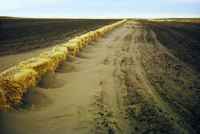
Rows of square bales can be set at right angles to the wind.
Courtesy of ARD
Back to Chapter 3 - Cropping Practices |
|